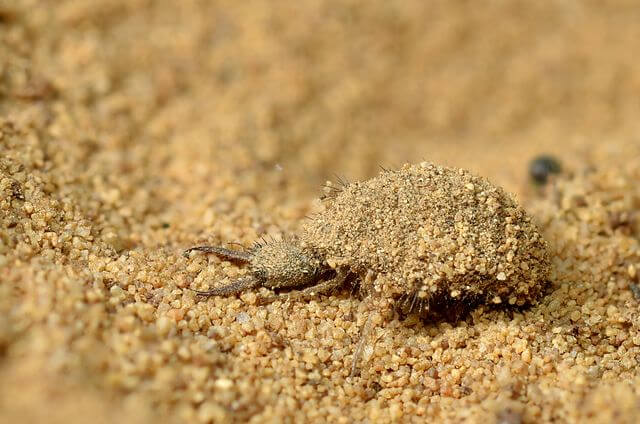Small-Scale Lion Tracking
By Theresa Duncan
Broadcast 7.2015, 8.2019, and 7.20 & 7.23.2022

Antlion larva in sand. Photo by Gilles San Martin, CC BY-SA 2.0.
Listen:
It was a hot summer day—the Fourth of July, to be exact. My granddaughter Abby and I were on our way to the woodshed. We were going to need a small fire later to roast our hot dogs and make our s’mores before heading into Hamilton to watch the fireworks. As we stepped under the shade of the ponderosa pines, I saw the tracks. “Abby, look! Do you see that?” As I pointed to the ground, her blank look was my answer. In the dry, fine, tan soil there were nearly invisible, squiggly marks, like doodles on the ground, and probably twenty-five small, funnel-shaped pits. “Look at the lion tracks,” I told her. “Oh, Nana,” she chuckled. “Lion tracks are bigger and look kind of like big cat tracks.” “This,” I said, “is a very different kind of lion.”
Found worldwide in arid and sandy habitats, antlions belong to the order Neuroptera. Adult antlions lay their eggs in dry, loose soil. Once hatched, the larvae crawl about in search of a suitable home site, leaving tracks that look like doodles. The same color as the soil, they are well camouflaged. Their broad, flattened bodies have short, stubby legs, best for their habit of crawling backwards, which is also aided by the curve of the nearly invisible hairs on their body. As they begin excavation, their oval-shaped abdomen plows through the soil, while their flat heads act like a shovel, flicking sand up and out of the pit. Continuing their backward, downward spiral, abdomen first, the cone-shaped pit is constructed. Once complete, the pit becomes the antlion’s home for up to three years.
Completely buried now except for its long, piercing mandibles, or jaws, which stick out of the center of the pit, the antlion larva lies motionless at the bottom, waiting for its first victim. An ant or a small insect steps inside the rim of the pit and begins the fight for life. The steep sides make it hard to crawl out. The antlion further confuses the process by flicking particles of sand or dirt onto the frantic insect, aiding its descent into the pit. At some point in the struggle, the insect falls into the bottom of the trap or is impaled by the antlion’s piercing mandibles. The predator drags its prey deeper into the sand, where it sucks out its body fluids. The antlion then calmly takes out the trash, flicking the carcass out of its pit, and awaits its next victim.

Illustration by Nicholas Caffarilla, CC BY-SA 3.0.
The larva develops in stages called instars, digging many pits, some as large as two inches in diameter and depth. The antlion, now about a half inch in size, pupates in a spherical, sand-covered cocoon for about a month in spring or summer. Upon complete metamorphosis, adult antlions resemble damselflies, 1½ inches long, with narrow, net-veined wings they hold over their long, skinny abdomens like pup-tents when they are at rest. Adult antlions live for one to two months.
Abby seemed doubtful of my explanation. “Catch one of those ants and drop it into a trap,” I told her. We hovered over an antlion’s pitfall trap and she released her ant into the center. Tiny sand particles began to move, partly from the ant’s churning legs and partly from the antlion tossing particles. All the movement happened so fast. Suddenly, the antlion’s mandible grabbed hold of the ant and pulled it down.
Now that the doodlebug was fed, it was time for us to go build that fire and make our own dinner.
Every week since 1991, Field Notes has inquired about Montana’s natural history. Field Notes are written by naturalists, students, and listeners about the puzzle-tree bark, eagle talons, woolly aphids, and giant puffballs of Western, Central and Southwestern Montana and aired weekly on Montana Public Radio.
Click here to read and listen to more Field Notes. Field Notes is available as a podcast! Subscribe on iTunes or wherever you listen to podcasts.
Interested in writing a Field Note? Contact Allison De Jong, Field Notes editor, at adejong [at] montananaturalist [dot] org or 406.327.0405.
Want to learn more about our programs as well as fun natural history facts and seasonal phenology? Sign up for our e-newsletter! You can also become a member and get discounts on our programs as well as free reciprocal admission to 300+ science centers in North America!












